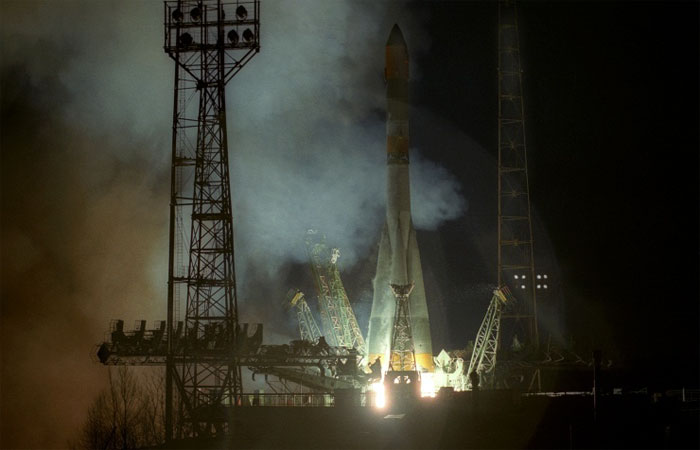.
25.11.2014

Another GLONASS satellite to be launched from Plesetsk space site December 1
This will be a second GLONASS-K satellite launched this year, the first satellite in the series currently in orbit is being flight-tested.
.
The next launch of Russian navigation satellite GLONASS-K from the northern Plesetsk space site, located in Russia’s Arkhangelsk region, is scheduled for December 1, Russian space agency Roscosmos told TASS on Monday.
“Another GLONASS-K satellite will be put into orbit by Soyuz 2.1b Russian carrier rocket from Plesetsk space site on December 1 at approximately 00:52am Moscow time (November 30, 9:52pm GMT)”, Roscosmos official said.
At the moment, the orbital cluster GLONASS consists of 28 satellites: 24 are operating in the routine mode and four in the reserve.
This will be a second GLONASS-K satellite launched this year. The first satellite in the series currently in orbit is being flight-tested.
Quelle: TASS
.
Update. 1.12.2014
.
Soyuz 2-1B lofts GLONASS K-1 satellite
A Russian Soyuz 2-1B has launched the much-delayed GLONASS K-1 Global Navigation satellite from the Plesetsk Cosmodrome. Launch from a chilly Pad 43/4 occurred at 21:52 UTC on Sunday, marking the second launch of this class of satellite, following on from the first that was lofted in 2011.
GLONASS K-1 Launch:
The Russian GLONASS Global Navigation Satellite System – operated by the Russian Aerospace Defence Forces – is currently the only global alternative to the American GPS fleet in operation that has global coverage of comparable precision.
Europe is currently working towards its Galileo system, while other countries are building their own GPS systems – such as the Chinese BeiDou Navigation Satellite constellation.
Development of GLONASS began in the Soviet Union in 1976. By the turn of the this decade, GLONASS had achieved 100 percent coverage, with the full orbital constellation of 24 satellites operational in 2011.
The Russians are continually launching GLONASS satellites, with varying success. One of the biggest failures came when three GLONASS-M birds were lost when their Proton-M launch vehicle dramatically failed during launch.
GLONASS-K is the latest version of the satellite design. Developed by Reshetnev Information Satellite Systems, the first satellite in this range was launched on 26 February, 2011. This latest satellite was set to launch the following year, ahead of several major delays.
The K Series are an advanced improvement of the previous M second-generation satellites, with longer lifespans and better accuracy.
Based on the Ekspress-1000A bus, the satellite utilizes L-Band navigation signals.
These two satellites will be eventually replaced by operational K series satellites, known as GLONASS K-2.
A Soyuz-2-1B rocket was used to launch the satellite.
The Soyuz-2 is the latest in a long line of Russian rockets derived from the R-7 missile, which became the world’s first intercontinental ballistic missile when it flew in 1957.
Payloads launched by R-7 rockets have included the first satellite, Sputnik 1; the first manned spacecraft, Vostok 1, and every subsequent Soviet or Russian manned mission; the first spacecraft to leave Earth orbit, Mechta (Luna 1), the first missions to impact and land on the Moon, Luna 2 and Luna 9, and many other significant missions.
The Soyuz is descended from the Voskhod rocket, an R-7 derivative which was developed to launch the Soviet Union’s second-generation manned spacecraft and reconnaissance satellites. Soyuz incorporated the Blok-I third stage originally developed for the Molniya rocket, but lacked the Molniya’s fourth stage.
Since its first flight in 1966, numerous modifications have been made. The original Soyuz was replaced by the Soyuz-U, which remains in service along with the Soyuz-FG, an improved derivative which is mostly used for manned launches of Soyuz-TMA spacecraft.
The Soyuz-2 is a more complete modernisation, and will eventually replace the Soyuz-U and FG.
Compared to the Soyuz-U, the Soyuz-2 has modernised first and second stage engines – the RD-107A and RD-108A respectively, which were introduced on the Soyuz-FG. It also includes modifications to the third stage, and a digital flight control system, features not present on the Soyuz-FG.
The third stage of the Soyuz-2-1A retains the RD-0110 engine used on previous variants, while the Soyuz-2-1B is propelled by an RD-0124.
A third Soyuz-2 variant, the Soyuz-2-1V, differs significantly from the rest of the R-7 family, consisting of only the second and third stages of the Soyuz-2-1B, without the first stage, and with an optional Volga upper stage.
For the 2-1V, the first stage (the 2-1B’s second stage) is powered by an NK-33 engine with an RD-0110R vernier. The 2-1v’s debut occurred at the end of 2013. Exclusive documentation on this vehicle was acquired by L2 (LINK).
The Soyuz-2-1B is a three-stage rocket by the numbering system used by Russia. Under the system more commonly used in the west, it would be regarded a two-stage rocket, with four strap-on boosters, however instead the strap-ons are numbered stage 1, the first core stage is numbered stage 2, and the second core stage is numbered stage 3.
The first and second stage engines ignited together, about 17 seconds ahead of launch, building up to full thrust before the four swing-arms holding the rocket down was released.
Following liftoff, the rocket flew for approximately 118 seconds before the first stage separated. The four strap-ons fell away from the rocket and back towards Earth, forming a pattern known as the Korolev Cross after Sergei Korolev, the designer of the R-7.
The second stage continued to burn for another 170 seconds, before separating from the third stage. The Upper Stage was then Fregate, providing the final thrust to place the satellite into it required orbit.
These missions usually launch from the Baikonur Cosmodrome.
Sites 16/2 and 43/4 at Plesetsk were originally not able to host the Soyuz 2. However, they have since been converted.
Quelle: NS
4446 Views
